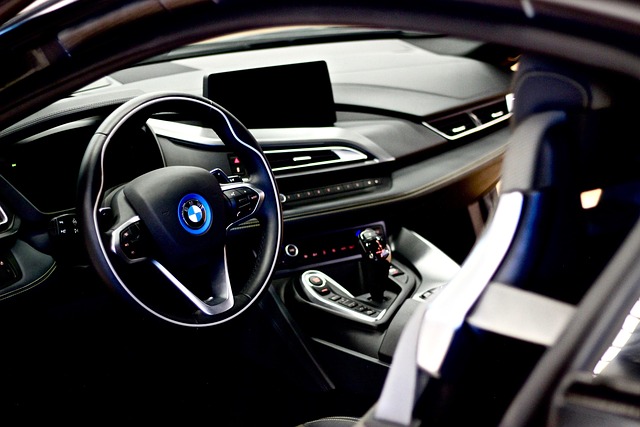Before upgrading your car stereo, understand your current system's components and functionality. Choose a new in-car infotainment system with hands-free driving features like advanced connectivity, voice commands, and intuitive interfaces. Prepare your vehicle by securing loose items, gathering tools, and identifying old stereo mounting points. Install the Select In-Car Infotainment System using supplied brackets, connect power cables, integrate displays, and test all functions. Calibrate speakers and adjust settings for optimal sound quality and personalized entertainment.
Are you ready to upgrade your car’s audio experience? Replacing an old car stereo with a modern in-car infotainment system is easier than you think. This guide will walk you through the entire process, from understanding your current stereo and its components, to selecting the right model for your needs, preparing your vehicle for installation, and finally, installing and calibrating your new Select In-Car Infotainment System.
- Understanding Your Current Stereo and Its Components
- Researching and Selecting the Right In-Car Infotainment System for Your Needs
- Preparing Your Car for Installation: Necessary Tools and Steps
- Installing Your New Select In-Car Infotainment System
- Testing, Calibration, and Final Adjustments
Understanding Your Current Stereo and Its Components

Before you start replacing your old car stereo, it’s crucial to understand its components and how it works. Your current stereo is likely a complex system that includes various modules like AM/FM tuners, CD players (if applicable), and an audio amplifier. These components work together to deliver sound to your vehicle’s speakers. Understanding this setup will help you choose the right replacement—a new in-car infotainment system.
When exploring options for a digital cockpit display or customizable car dashboards, consider what features are essential for hands-free driving navigation. Modern infotainment systems offer advanced connectivity, voice commands, and intuitive interfaces that enhance your driving experience. Select a stereo that integrates seamlessly with your vehicle’s onboard computer and provides a user-friendly interface for easy access to music, podcasts, and navigation without taking your eyes off the road.
Researching and Selecting the Right In-Car Infotainment System for Your Needs

When it comes to replacing your old car stereo, choosing the right In-Car Infotainment system is key. Start by evaluating your needs and preferences. Today’s advanced systems offer a range of features from real-time traffic updates and voice command for climate control to sophisticated user-friendly interface design. This ensures you can stay connected, comfortable, and entertained while on the road.
Consider your daily driving habits and what matters most to you. If you’re often in heavy traffic, real-time navigation will be invaluable. For those who value hands-free convenience, voice commands for various functions can significantly enhance your driving experience. A user-friendly interface design ensures easy operation, even if you’re not tech-savvy, allowing you to focus on the road while enjoying your chosen entertainment.
Preparing Your Car for Installation: Necessary Tools and Steps

Before installing a new car stereo, it’s crucial to prepare your vehicle for the change. Begin by ensuring all loose items in the cabin are secured to prevent them from shifting during installation. This includes removing any heavy objects from the floor and fastening down loose items like drinks holders or storage trays. Next, gather the necessary tools: a set of screwdrivers (both flathead and Phillips), a spanner or wrench for removing larger bolts, and possibly an antistatic wrist strap to protect your car’s electronic components.
Now, locate the old stereo and identify its mounting points. Typically, this involves removing the faceplate and accessing the screws or clips securing it in place. Be mindful of where each component is connected, especially if your modern car audio trends include a touchscreen infotainment console or a car infotainment with Bluetooth. Once you’ve identified these connections, carefully disassemble the old stereo, keeping track of any cables or wires for proper disposal or reuse. This meticulous preparation will make the installation process smoother and ensure a secure fit for your new in-car infotainment system.
Installing Your New Select In-Car Infotainment System

Installing your new Select In-Car Infotainment System is a straightforward process designed to minimize disruption and maximize enjoyment. First, ensure your vehicle’s dashboard is clean and dry to facilitate smooth mounting. Next, carefully unpackage your infotainment system, taking note of any included accessories such as cables and adapters specific to your car make and model. Compare the provided components with your vehicle’s existing layout to ensure a perfect fit.
Once ready, detach the old stereo with minimal force, marking key connections for easier reassembly. Install the new Select In-Car Infotainment System by securing it firmly in place using the supplied brackets or mounting hardware. Connect the power cable, ensuring all wiring is neatly routed and secured. Integrate your high-resolution car display and GPS mapping software to enhance navigation capabilities, aligning them with modern car audio trends. Test all functions thoroughly before driving off, enjoying the upgraded infotainment experience that comes with your new Select In-Car Infotainment System.
Testing, Calibration, and Final Adjustments

After carefully selecting and installing your new car stereo, it’s time to ensure everything functions flawlessly. Begin by testing the various features such as audio playback, radio reception, and Bluetooth connectivity. Verify that all controls are responsive and intuitive. Next, calibration is crucial for optimal sound quality, so use the built-in calibration tools or professional software to fine-tune the speakers’ output. This step ensures your new stereo provides an even and rich audio experience across all frequencies.
Finally, make sure to adjust settings like volume levels, EQ presets, and user preferences to match your driving and listening habits. Modern car stereos often come with advanced features like GPS mapping software and voice recognition infotainment, enhancing navigation and control. By personalizing these settings, you’ll enjoy a seamless blend of entertainment for all ages, making every journey more enjoyable.
Replacing your old car stereo is a straightforward process that can significantly enhance your driving experience. By understanding your current system, researching suitable alternatives, preparing your vehicle, and following the installation steps closely, you can have a new, modern In-Car Infotainment system up and running in no time. With the right tools and knowledge, you’ll be enjoying crystal-clear audio, advanced connectivity, and intuitive navigation features before you know it.
